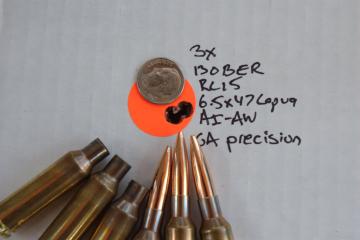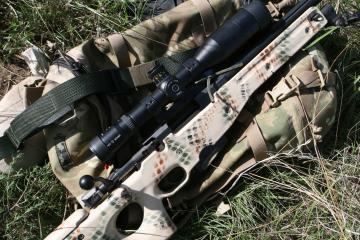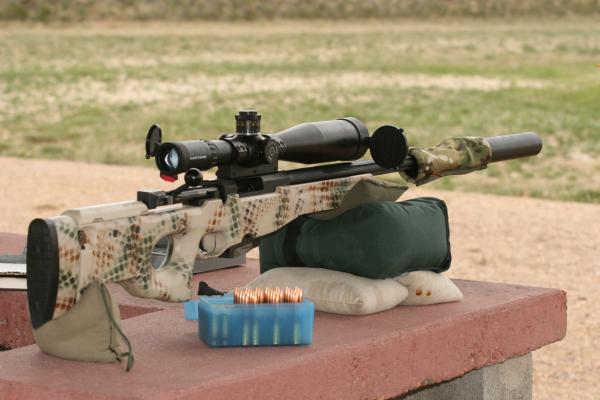6.5x47 Lapua
In cooperation with Grunig & Elmiger, Lapua set out to develop a cartridge optimized for European
300-meter CISM competition. Similar to our NRA High-Power, 300-meter CISM has a set course of fire
from defined shooting positions using highly specialized target rifles. The caliber that currently
dominates 300-meter CISM is the 6 mm BR Norma due to its excellent accuracy, good ballistics, and
low recoil. As the project officially started in 2005, two initial project goals were to improve
ballistics by decreasing wind drift and to reduce barrel wear compared to the 6 mm BR Norma, which
will get only about 2500 rounds at top accuracy before the barrel starts to show wear.
The 6.5x47 Lapua case is about three-tenths of an inch shorter than a .260 Remington case, and has a sharper shoulder and a longer neck. With an overall loaded length of 2.700 to 2.800 inches, most bullets can be seated with their rear bearing surface above the case shoulder. It can be thought of as a shortened and "improved" .260 Remington case, with a small primer pocket. Factory 6.5x47 Lapua loads shoot the 139-grain Lapua Scenar at 2690 fps, the 123-grain Scenar at 2790 fps, or the 108-grain Scenar at 2950 fps.
The Gun
I was approached by the editor of 6mmBR.com in early 2007 about the opportunity to build a "Tactical
Rifle" - a rifle intended for the field-style practical rifle matches - in 6.5x47 Lapua, in order to
really get a feeling of how the cartridge stacked up against the conventional .308 and the
now-becoming-standard .260 Remington. So I unscrewed the factory .308 barrel from my other
Accuracy International AW (AI-AW), and screwed on a barrel that George Gardner had cut from a Satern
blank. This barrel finished at 25.3 inches and we added six flutes to cut down on weight since the
barrel came with a heavy profile. I like my guns set up the same for continuity, so this rifle was
topped with another S&B 3-12x50mm PMII. Again, the suppressor was used for most shooting. At this
point, I had two identical AI-AW rifles- one set up in .260, one set up in 6.5x47 Lapua.
Bottom-line: Load, Ballistics, Accuracy
Final load: 123gr Lapua Scenar @ 2930 fps, 37.2gr RL15, CCI BR4, Lapua brass.
From a 100-yard zero, this load needs 7.2 mils of elevation to 1000 yards, and will drift 59 inches with a 10 mph cross. Accuracy is excellent at 1/4 MOA or better. 123 6.5x47 Lapua @ 2930 Zero 100yd 5000' Density Altitude RANGE ELEV- moa mil | WIND(10) moa mil RANGE 100 0" 0.00 0.0mil | 0" 0.50 0.1mil 100 200 2" 1.25 0.3mil | 2" 1.00 0.3mil 200 300 10" 3.25 0.9mil | 4" 1.50 0.4mil 300 400 23" 5.50 1.6mil | 8" 2.00 0.6mil 400 500 42" 8.00 2.3mil | 13" 2.50 0.7mil 500 600 68" 10.75 3.2mil | 19" 3.00 0.9mil 600 700 102" 14.00 4.0mil | 27" 3.75 1.1mil 700 800 145" 17.25 5.0mil | 36" 4.25 1.2mil 800 900 197" 21.00 6.1mil | 47" 5.00 1.4mil 900 1000 260" 24.75 7.2mil | 59" 5.75 1.6mil 1000 Load Development Notes
Using Lapua brass, bullets from Lapua and Berger, and a variety of powder and primers, I tested no
less than 45 combinations looking for the "best" overall performer. Besides excellent accuracy and
consistency, I also wanted optimum ballistic performance for long-range UKD courses of fire with
100% reliability-- there are no sighters or alibis in practical competition. It was almost
immediately clear that the pressure limiter in 6.5x47 in the AI-AW rifle would be the primer
piercing issue I originally saw with the .260. Ignoring the primer issue, even with nuclear loads
substantially exceeding my final load, there were never any pressure signs on the case head, nor was
the bolt hard to lift.

Without the primer issue, the following ballistics would have been possible based on the experimental results: a 139-grain Lapua Scenar at 2850 fps; a 123-grain Lapua Scenar at 3080 fps; and a 130-grain Berger VLD at 2950 fps. RL15 is the powder for 6.5x47 Lapua. Similar results were had using H4350 and N550, but the RL15 seemed more predictable and was more consistent. With regard to primer selection, CCI 450, BR2, and #41 all gave similar results.
Ammo and Components
Because this cartridge was designed from the ground up for European long-range competition (in this
case only 300 meter), Lapua has factory loads for the 108, 123, and 139-grain Scenar. Factory
6.5x47 Lapua loads shoot the 139-grain Lapua Scenar at 2690 fps, the 123-grain Scenar at 2790 fps,
or the 108-grain Scenar at 2950 fps. Testing of factory Lapua ammunition showed that the published
velocities are a little conservative. The 123-grain loads shot at 2820 fps from my 25.3-inch barrel
and consistently held half-MOA or better groups.
As for components, the Lapua brass is excellent quality as usual, and costs about $0.65/pc if purchased in bulk. I did zero - zero - brass prep during load testing and accuracy and consistency was excellent. The Lapua brass is very strong. Pros

Cons
Match Performance
I shot the 6.5x47 AI-AW at the August 2007 Sporting Rifle Match. After the main match, John S. (also
shooting 6.5x47) and I were tied for second place. John edged me out with a better wind call in the
sudden-death shootout on the known-distance range, so I ended up third overall. I try to console
myself that his higher-BC 130-grain JLK bullets with a 40 fps edge over my 123-grain Scenars at 2930
fps had something to do with it. The overall match winner was using a straight .260 Remington and
just beat us by three points at the end of the match. In the field, the performance of the .260
Remington is almost indistinguishable from the 6.5x47 Lapua.
The second big match I shot the 6.5x47 rifle at was the 2007 Camp Guernsey Invitational Multi-Gun Match, put on by Colorado Multi-Gun at the National Guard base near Guernsey, Wyoming. This was a match for long-range rifle, carbine, and pistol, with carbine targets to 330 yards and rifle targets to 700 yards. Thirty-eight shooters competed through seven "run and gun" stages, including one night stage, over two days in the terrain of the base. An accurate rifle, rock-solid data, and the light-recoiling 6.5x47 helped me dominate one of the two long-range stages, giving me the match points for an overall win.
Summary
In the field, .260 and 6.5x47's performance is virtually indistinguishable. The lighter 123-grain bullet I
settled on for the 6.5x47 has only about five inches more drift (per 10 mph cross) at 1000 yards
than my 139-grain .260 load, but is one-fifth of a mil flatter at the same distance. Viscerally, the
heavier .260 bullet produces more impact signature when impacting long-range steel targets-- but a
hit's a hit. Ultimately, I lost some ballistic performance with the 6.5x47 vs. the .260 due to the
pressure limitations in my rifle.
|
